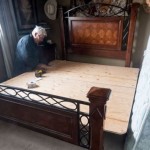How To Convert Your Crib Into A Toddler Bed
Converting a crib into a toddler bed is a cost-effective and environmentally friendly way to transition a child to the next stage of sleep. This process typically involves removing one or more crib sides and potentially adding a toddler rail. While the specific steps vary depending on the crib model, the underlying principles remain consistent. This guide outlines the general process and important safety considerations.
1. Consult Your Crib's Instruction Manual
The most crucial first step is to consult the crib's instruction manual. Manufacturers design cribs with specific conversion mechanisms, and the manual provides detailed instructions tailored to your model. These instructions will outline the necessary tools, the correct removal and attachment procedures, and any specific safety measures. Retaining the manual throughout the crib's lifespan is essential for safe and proper conversion.
If the manual is unavailable, contact the manufacturer directly. Many manufacturers have online resources, including downloadable manuals. Attempting conversion without the manufacturer's guidelines can compromise the bed's structural integrity and create safety hazards.
2. Gather Necessary Tools and Materials
Once the instructions are reviewed, gather all required tools. Commonly needed tools include screwdrivers (Phillips and flathead), Allen wrenches, and possibly a hammer. Having these tools ready beforehand streamlines the process and prevents interruptions. The instruction manual will specify the exact tools needed for your crib model. Using incorrect tools can damage the crib's components.
In addition to tools, ensure you have the necessary hardware. Some cribs require specific screws or bolts for the toddler bed conversion. These components are often included with the original crib purchase. If these parts are missing, contact the manufacturer to obtain replacements. Using incorrect hardware can lead to instability and safety risks.
3. Remove the Crib Side
The core of the conversion process involves removing one side of the crib. The instruction manual will specify which side is intended for removal in toddler bed mode. Typically, this is the front side, providing easier access for the child. Follow the manufacturer's instructions precisely to ensure correct disassembly. Forcing components can damage the crib's structure.
Carefully detach any hardware securing the crib side to the headboard and footboard. Keep these components organized for potential reassembly if converting back to a crib or for future use. Once the hardware is removed, gently detach the crib side. Depending on the crib's design, this may involve sliding, lifting, or unhooking the side.
Some cribs feature drop-side mechanisms. If your crib has this feature, ensure it is fully disabled and locked in place before proceeding. Drop-side cribs have been associated with safety concerns, and proper disabling is critical for the child's safety.
4. Install the Toddler Rail (If Applicable)
Many cribs include a toddler rail, a low guardrail that prevents the child from rolling out of bed. If your crib includes a toddler rail, follow the manufacturer's instructions for installation. This typically involves attaching the rail to the headboard and footboard using the provided hardware. Ensure the rail is securely fastened to prevent accidental detachment.
Not all cribs require a toddler rail. Some models utilize the lowered crib side as a sufficient barrier. Refer to the instruction manual to determine if a toddler rail is necessary or included with your crib model. If a toddler rail is not included but desired, contact the manufacturer to inquire about compatibility and purchase options.
5. Inspect and Test the Converted Bed
Once the conversion is complete, thoroughly inspect the bed for stability. Ensure all hardware is tightly secured and that there are no loose parts or sharp edges. Test the bed's sturdiness by gently applying pressure to various points. A stable bed should not wobble or creak excessively.
Check the height of the remaining sides. The child should be able to safely get in and out of bed without assistance. If the sides seem too high, consider lowering the mattress height if the crib allows for adjustable mattress positions. Maintain a safe distance between the top of the mattress and the top of the side to prevent falls.
Finally, examine the area around the bed. Remove any potential climbing hazards, such as furniture or cords, that could allow the child to climb out unsafely. Maintaining a clear safety zone around the bed minimizes the risk of falls and injuries.

From Crib To Toddler Bed Diy Old Cribs

How To Move Your Child From Crib Toddler Bed Safely

How To Turn A Crib Into Toddler Bed With Pictures Wikihow

Everything You Need To Know About Crib Conversion A Children S Bed With Very Little Time Energy Simply September

Everything You Need To Know About Crib Conversion A Children S Bed With Very Little Time Energy Simply September

How To Turn A Crib Into Toddler Bed With Pictures Wikihow

Transitioning Toddler From Crib To Bed Everything You Need Know

Do It Yourself Divas Diy Old Crib Into Toddler Bed

Crib To Toddler Bed Transformation Clever Housewife

When To Transition From A Crib Toddler Bed







